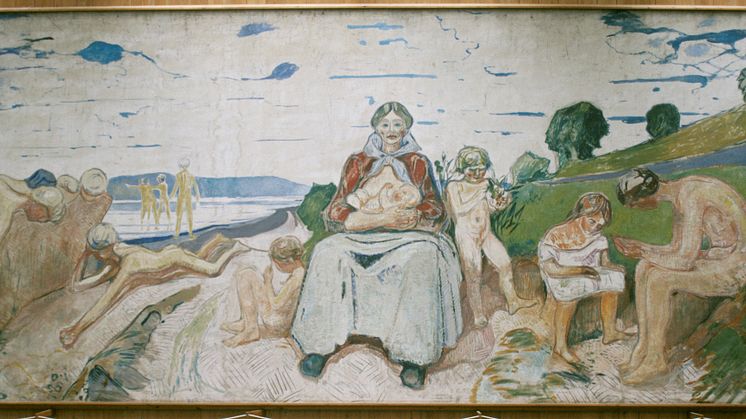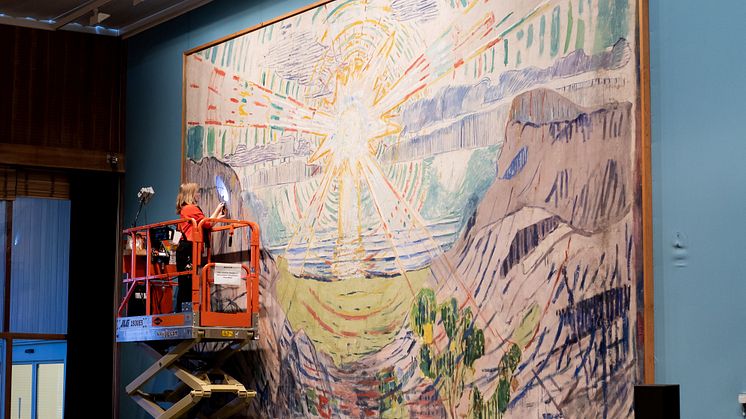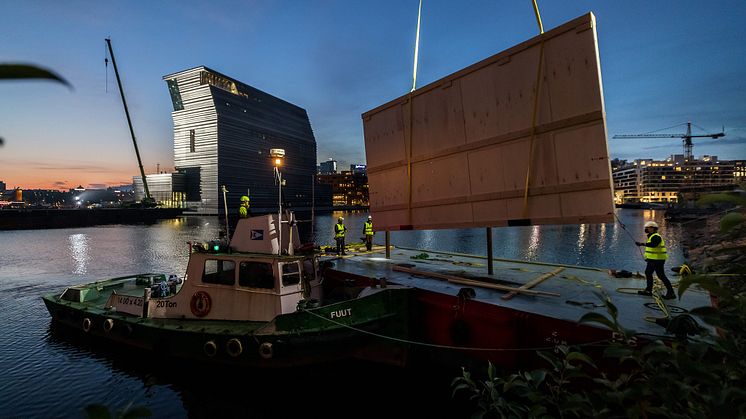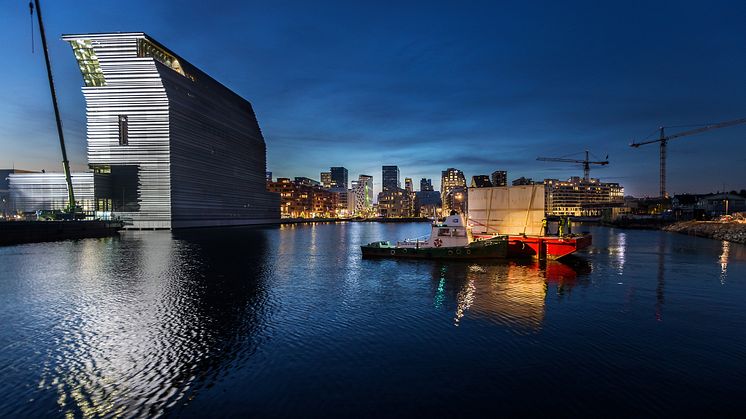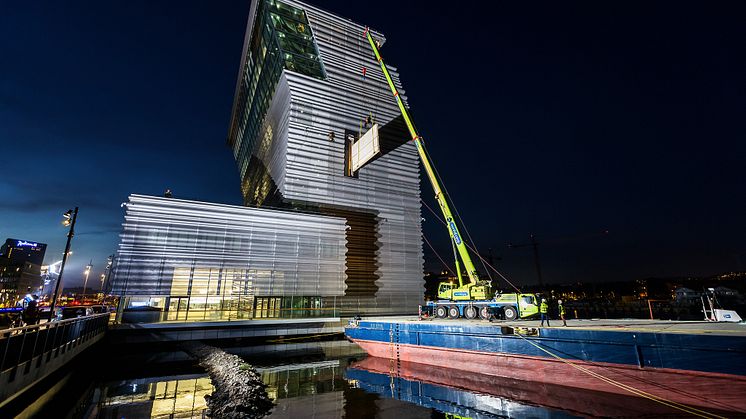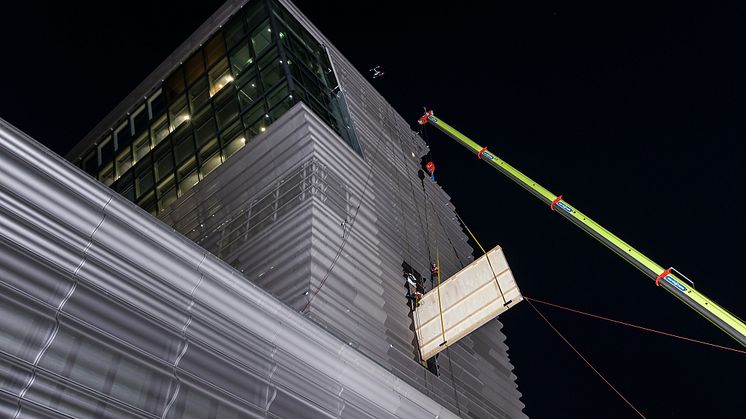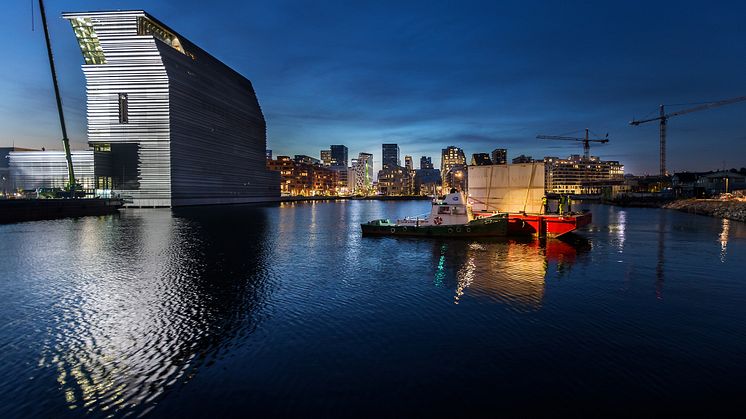
Press release -
A SPECTACULAR HISTORIC MOMENT FOR MUNCH
The first Edvard Munch artwork is relocating to its new home, the new MUNCH set to open 22 October. Artworks with dimensions upwards of 5 x 11 metres will be lifted through the roof of the old museum and making their way down to the new MUNCH’s fjord-side location. A crane is hoisting them through a large wall slit on the sixth floor. This large and complicated operation is a spectacular moment.
Two of Edvard Munch’s paintings – The Sunand The Researchers are so gigantic that a specially made slot had to be opened through the wall of the sixth floor to get the works to their new perch by the Oslo Fjord Monday evening. The works are being transported in custom-made crates by trucks and then at water’s edge moved to a barge. A crane will then hoist them to the opening in the building on its sixth floor, 21 metres up. After that, the 60cm-wide slot in the side of the museum will be sealed shut – for good.
- This operation is very demanding and has been planned for a long time and involves many of our employees and partners. When the works are safe inside the new MUNCH, they will remain there as long as the museum exists. The room, which is specially made for Edvard Munch's monumental work, extends over two floors and becomes a great place for events surrounded by Munch's art, says director at MUNCH Stein Olav Henrichsen.
About the artworks
Works like these are fittingly defined in the artworld as monumental, and these two will form the nexus of the permanent exhibition. The two largest paintings, The Sun and The Researchers, were painted by Edvard Munch in connection with a commissioned competition in 1909 to decorate the University of Oslo’s ceremonial hall, the Aula. Edvard Munch won the competition and the Aula paintings were amongst the most demanding projects of his career. The artist worked intensely from the launch of the competition in 1909 to the presentation of his final versions of the paintings to the public in 1916. He painted and stored several hundred drafts and sketches, and these are also part of the MUNCH’s collection today. Some can be viewed at the permanent exhibition “Edvard Munch Monumental” when the museum opens 22 October.
The Sun is one of Munch’s major works. The version owned by MUNCH, moving into its new home at Bjørvika, is a full-sized draft for the Aula frieze that the artist made in 1910-11. The oil painting’s size is about 4.5 x 8 metres – approximately 35 square metres.

The Sun Oil on canvas from 1910-1911, is one of the two largest works being slid through the wall of the new museum building at Bjørvika on 31 May. Winds are known to gust at Bjørvika – so the move had to be timed with fair weather.
The Researchers is the largest of the works, with dimension of 4.8 times 11 metres. The title refers to the children on the beach, digging in the sand and exploring the world around the woman at the middle, breastfeeding an infant. She evokes associations of the Virgin Mary if perceived through the eyes of a Christian visual culture. But she is often interpreted more generally to be a symbol of the mother of the university, giving nourishment and energy to new generations. Or she could be the mother of the universe. In fact, the painting was often referred to as “Mother Earth” in newspaper articles and in interviews with Munch himself.

The Researchers, 1911-1925 Oil on canvas and the second work to be hoisted through a slot high up on the wall of the new MUNCH. The painting measures 4,8 times x 11 metres without a frame.
MUNCH is home to the world's largest collection of works by Norwegian artist Edvard Munch. In Spring 2021, MUNCH will open in a brand new building on Oslo’s waterfront. The bespoke structure, designed by estudio Herreros, will house more than 26,000 works that Edvard Munch bequeathed to the City of Oslo. The museum also manages collections donated by Rolf Stenersen, Amaldus Nielsen and Ludvig Ravensberg.
The new museum will trace the artist’s profound influence both on modern art and on artists through to the present day. Alongside displays of iconic artworks from the renowned permanent collection, temporary exhibitions will show Edvard Munch’s lasting influence in his own contemporary society, as well as on today’s generation of artists.
Visitors will experience the highlights of Edvard Munch’s oeuvre, in parallel with a wide-ranging programme of cultural events and experiences for visitors of all ages. From its location in Bjørvika, with unparalleled views of the Oslo Fjord, the museum will offer an extensive program of art and cultural experiences across thirteen floors.

